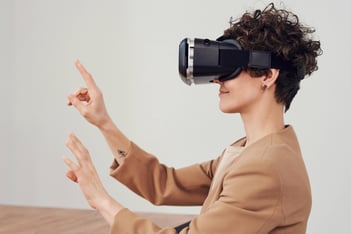Construction sites are inherently dangerous with risks ranging from falls and equipment accidents to hazardous materials exposure. Despite rigorous safety protocols, the industry continues to face high rates of accidents and injuries – in fact, the construction industry has the second-most workplace deaths of all industries with fatalities increasing by 11% from 2021 to 2022.
Fortunately, innovative technologies are transforming the landscape of construction safety, providing new tools and methods to mitigate risks and protect workers. Here’s a look at some cutting-edge technologies enhancing safety and efficiency on construction job sites.
Read: Robots, Drones, AI – Oh, My! Innovative Technologies for Construction
1. Wearable Technology
Wearable devices, such as smart helmets, vests, glasses and boots, are becoming increasingly prevalent on construction sites. These devices are equipped with sensors and communication devices that monitor various parameters, including:
- Vital signs: Wearables can track heart rate, body temperature, blood pressure and fatigue levels, alerting workers and supervisors if someone is at risk or overheating, overexertion or other health issues in real-time.
- Location tracking: GPS-enabled wearables help track workers’ location, ensuring they are safe and within designated work areas. This is particularly useful for emergency evacuations or finding a worker in distress.
- Fall detection: Sensors in smart helmets or belts can detect falls and shocks and immediately alert emergency response teams, reducing the time needed to provide assistance.
- Hazardous materials: Wearable technology can also detect nearby hazardous gas levels or extreme temperatures and alert the wearer about the potential danger.
2. Drones and Aerial Surveillance
Drones are revolutionizing how construction sites are monitored while also reducing the risk of accidents.
- Site inspection: Drones provide a bird’s-eye view of the site, enabling remote supervisors to conduct thorough inspections without putting themselves at risk. They can quickly identify potential hazards such as unstable structures or unsafe work practices that might not be visible from the ground.
- Progress tracking: Regular drone flights can document the progress of construction projects in real-time, ensuring safety protocols are followed at every stage.
- Accident investigation: In the event of an accident, drone footage can help reconstruct the incident to understand what went wrong and prevent future occurrences.
Read: 5 Top IT Trends Transforming Construction and Design
3. Virtual Reality (VR) and Augmented Reality (AR)
VR and AR offer immersive training and real-time assistance to construction workers and supervisors.
- Safety training: VR can simulate construction site environments, allowing workers to practice safety procedures and respond to emergency situations in a controlled, risk-free setting. This hands-on training is more effective than traditional methods.
- On-site assistance: AR can overlay safety information and guidelines directly onto the worker’s view through smart glasses. For instance, it can highlight potential hazards or display machinery operation manuals.
4. The Internet of Things (IoT)
IoT devices interconnect various systems and equipment on a construction site, creating a smart network.
- Equipment monitoring: Sensors on machinery can monitor their condition and usage, predicting maintenance needs and preventing malfunctions that could cause accidents and downtime.
- Environmental monitoring: IoT sensors can track environmental conditions like air quality, noise levels, humidity and temperature, alerting workers if conditions become unsafe.
- Hazard detection: IoT-enabled smart barriers and safety nets can detect when someone is approaching a dangerous area and trigger alarms or safety measures.
Read: 4 Ways Technology Is Holding Your Construction Firm Back
5. Building Information Modeling (BIM)
BIM technology involves creating 3D representations of a construction project’s physical and functional characteristics.
- Risk assessment: BIM allows for detailed planning and visualization, helping to identify and mitigate potential risks before construction begins.
- Collaboration and communication: BIM facilitates better communication among stakeholders, ensuring that safety protocols are well understood and adhered to by everyone involved in the project.
- Real-time updates: Any changes in the construction plan can be instantly updated in the BIM model, ensuring that all workers have access to the latest safety information and instructions.
6. Artificial Intelligence
Artificial Intelligence (AI) is enhancing predictive safety measures and improving decision-making processes in the construction industry.
- Predictive analytics: By analyzing data from various sources, AI can predict potential safety incidents and suggest preventative measures. This includes identifying patterns that may lead to accidents and proposing ways to address them.
- Safety compliance: AI can continuously monitor site activities to ensure compliance with safety regulations, automatically flagging any deviations for immediate correction.
- Decision-making: AI can use data from sensors, drones and IoT devices to help supervisors make informed decisions that improve productivity and construction processes.
Read: AI for Your Industry: Construction and Design
Stay Safe with Innovative Technologies
These modern, innovative technologies are transforming the construction industry, keeping workers safe and enhancing construction efficiency. As more technologies come to the market, construction businesses must stay aware of them.


